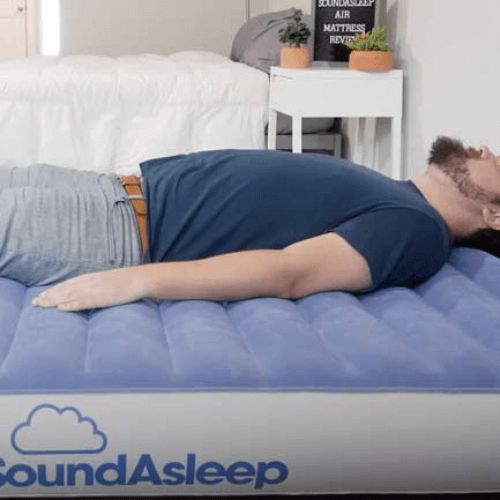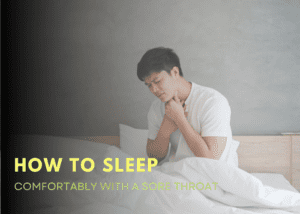A study published in The Lancet reveals that nearly one-third of people who sleep on an air mattress long-term develop chronic health problems.
This alarming statistic is a stark reminder of the potential risks associated with sleeping on an air mattress. For those without access to a traditional bed or mattress, these dangers are especially relevant.
Even if you’re only using your air mattress temporarily, it’s important to understand the risks and take steps to mitigate them.
In this article, we’ll outline the dangers associated with sleeping on an air mattress and provide tips for reducing your risk.
Risks Of Sleep Deprivation

As humans, sleep is a sacred part of our lives that we cannot live without.
We sometimes forget its importance, and take it for granted until the unavoidable toll of sleep deprivation begins to take its course.
While sleeping on an air mattress has its advantages, it also comes with serious risks.
One of those risks is deprivation of quality sleep.
Poor quality of sleep can lead to a wide range of health issues such as fatigue, irritability, and difficulty concentrating.
It can also affect our ability to remember things and make decisions. A lack of restful sleep may even lead to depression or anxiety.
Besides physical repercussions, poor sleep patterns can have social implications as well. If you are not getting enough restful nights, your relationships with family and friends may suffer due to moodiness or lack of focus.
This in turn can cause more stress which will further affect your quality of sleep – creating a vicious cycle.
It is important to understand what kind of air mattress is right for you before you make the investment so that you are not at risk for any adverse effects from a lack of quality restful sleep.
Understanding The Different Types Of Air Mattresses
Air mattresses are popular as a means of sleeping, but understanding the different types is essential. According to one survey, 31% of campers prefer air mattresses for camping trips.
It’s important to note that not all air mattresses are created equal. Inflatable air mattresses come in various sizes and materials, so it’s best to do some research before making a purchase.
The most common type is the inflatable mattress. These come in traditional sizes such as twin, full or queen and have an inner core made from either plastic or rubber.
They can be filled with air using an electric pump or manually by blowing into them.
These may provide more comfort than sleeping on the ground, but they can be uncomfortable if they aren’t inflated correctly or if they leak air during the night.
The other type of air mattress is a self-inflating mattress which has foam inside and uses your body weight to fill itself when you lay down on it.
This type of mattress provides more comfort than an inflatable one but can be much heavier and harder to transport due to its foam core.
Additionally, it can also be more expensive than an inflatable version.
No matter which type you choose, consider potential allergens that could be present in the material used to make the mattress such as dust mites or pet dander.
Potential Allergens In Air Mattresses
Allergens can be a problem when it comes to air mattresses.
Dust mites, pollen, and pet dander are just some of the allergens that may be present in an air mattress. They can cause irritation to those with allergies, leading to congestion and other respiratory symptoms.
The material used to make air mattresses also increases the potential for allergens to accumulate.
It’s important to choose an air mattress made from hypoallergenic materials if you or someone in your family suffers from allergies.
Air mattresses also require regular cleaning and maintenance to reduce the presence of allergens.
Vacuuming regularly and using hypoallergenic covers can help reduce the buildup of dust mites and other allergens on the surface of the mattress.
It’s also important to check for any signs of mold or mildew growth as this can exacerbate allergy symptoms and potentially worsen existing health conditions.
When using an air mattress, it’s important to remember that allergens may be present and take steps to minimize their effects.
Regular cleaning and proper maintenance should help reduce allergen accumulation on the mattress surface, ensuring a comfortable sleeping experience for everyone involved.
With that said, the next step is looking at how air mattresses provide unsuitable support for the spine.
Unsuitable Support For The Spine

As the clock strikes midnight, you lay your head down on your air mattress.
You expect a peaceful sleep, but instead are met with an uneasy feeling.
Without proper support for the spine, sleeping on an air mattress can be dangerous.
For starters, air mattresses lack the structural rigidity needed to properly support the spine in its natural curvature. This can lead to neck and back pain over time as well as difficulty falling asleep due to discomfort.
Furthermore, if you already suffer from chronic neck or back pain, lying on an air mattress could make these conditions worse.
Poor spinal alignment isn’t the only risk associated with sleeping on an air mattress either; it can also cause pressure points that can be incredibly uncomfortable and even lead to numbness or tingling of the limbs while sleeping.
All of these issues can cause even more disruptive sleep than before and leave you feeling tired and groggy during the day.
These risks should not be taken lightly; it’s important to make sure your bed provides a comfortable and supportive environment for restful sleep.
Otherwise, you may find yourself sacrificing quality rest for a few nights of convenient comfort – something no one should have to do.
Lack Of Structural Rigidity
There is more to consider when it comes to sleeping on an air mattress than meets the eye.
One of the many potential issues is the lack of structural rigidity, which can have significant implications for your health and comfort.
Let’s take a look at what this means and how it can affect you.
The lack of structural rigidity in air mattresses can leave you with a less than ideal sleep experience.
The material used in air mattresses is not designed to provide appropriate support for your body, leaving you without adequate spinal alignment throughout the night. This can lead to:
- Muscular aches and pains
- Poor quality sleep
- Insomnia or other sleep disturbances
- Waking up feeling unrested
- Irritability or fatigue during the day
This lack of support also makes air mattresses prone to developing uncomfortable lumps and bumps over time, further reducing the quality of your sleep experience.
While some people are able to get used to sleeping on an air mattress, it’s important to weigh up the potential risks before making your decision.
Poor Air Quality And Potential Health Hazards
Poor air quality and potential health hazards should be considered when sleeping on an air mattress.
Off-gassing from the material of the mattress can lead to poor indoor air quality.
This can cause respiratory irritation, headaches, nausea, and even dizziness. In addition, allergens and dust mites can easily accumulate in the mattress over time.
The trapped air also makes it difficult to keep the mattress clean which increases health risks.
Keeping an air mattress clean is difficult due to trapped moisture and sweat that can accumulate in the bedding.
This can create a breeding ground for bacteria, fungi, and other harmful microorganisms that can cause illnesses such as athlete’s foot or skin infections.
Additionally, mold spores may develop in damp mattresses if left unchecked and not cleaned regularly.
The potential health risks associated with sleeping on an air mattress make it important to take preventative measures.
Air mattresses should be thoroughly inspected upon purchase for any defects or rips that could create further issues down the line.
Allergen-resistant covers should also be considered when using an air mattress for long periods of time.
With proper care and maintenance, the risks associated with sleeping on an air mattress can be minimized significantly.
Pressure Points And Painful Pressure Ulcers
It’s like throwing a pebble into a pond, the pressure points and painful pressure ulcers on an air mattress can ripple out and cause great discomfort.
Like sitting on pins and needles, these uncomfortable points can make even the most restful sleep seem impossible. Here are some of the problems that can arise:
- Support Issues: When users don’t receive adequate support in certain parts of their body while sleeping, it causes them to sink deeper into the mattress. This leads to more concentrated pressure that can cause pain or bruising.
- Limited Mobility: Another problem is when users have limited mobility due to age or other health issues, which makes changing positions difficult. This means they might not be able to shift during the night to avoid developing pressure points.
- Sore Spots: Finally, sore spots often develop over time as people use their mattress in one position for too long. These spots become increasingly painful with prolonged use, making it hard for users to get comfortable again.
Uncomfortable pressure points are just one of many potential issues associated with air mattresses; air leaks and inflation issues will be discussed next.
Air Leaks And Inflation Issues

Leaks and inflation issues abound with air mattresses. It’s not just a minor annoyance, either.
A leaky mattress won’t give you the support you need for a good night’s sleep. And if your mattress isn’t properly inflated, it won’t retain its shape and could become uncomfortable.
In other words, it won’t do its job properly.
In addition to being uncomfortable, an improperly inflated air mattress can sag in the middle and create additional pressure points that can cause pain and stiffness in your back or neck when you wake up.
This is especially true if you’re sleeping on an old or worn-out mattress.
It’s important to regularly check your air mattress for leaks and make sure it’s properly inflated so that you don’t have to deal with these issues each night.
That way, you can ensure a good night’s rest without worrying about potential dangers associated with air mattresses.
Alternatives To Air Mattresses
Air mattresses have some serious drawbacks, including limited durability. But if you’re looking for an alternative sleeping solution, there are plenty of options.
Here are five alternatives to consider:
- Inflatable Pool Lounger – These are a great way to bring comfort camping or to the beach. These loungers can be inflated with a pump and provide hours of relaxing comfort with their contoured shape and supportive backrest.
- Foam Mattress Topper – For those without space for a full-size mattress, a foam mattress topper is an excellent choice. It’s lightweight, easy to store, and offers superior support and comfort compared to air mattresses.
- Futon – A futon is an affordable and versatile option that can work as both a sofa and bed in one piece of furniture. It’s perfect for small spaces and provides firm support while still being comfortable enough for sleeping.
- Camping Cot – A camping cot is a great way to get off the ground when camping outdoors or at home in your backyard tent. They can be easily folded up for storage when not in use, making them perfect for those who don’t have much room but need extra sleeping space from time-to-time.
- Hammock – A hammock is an ideal solution for those seeking an outdoor escape from the everyday hustle and bustle of life. They’re made from durable materials that can withstand the elements, so you can relax worry-free in your own slice of paradise anytime you want it!
When it comes to finding a comfortable place to sleep without breaking the bank, these five alternatives are worth considering as they offer superior comfort, portability, and durability compared with air mattresses while still providing plenty of relaxation opportunities whenever needed!
Frequently Asked Questions
How Often Should An Air Mattress Be Replaced?
An air mattress is a convenient way to get a good night’s sleep, but it’s important to know when to replace it, too. If the mattress is older than three years, it’s time for an upgrade.
Like a worn-out pair of shoes, an old air mattress can start to sag and create uncomfortable pressure points while sleeping.
It’s also important to check the seams of the air mattress for any rips or tears that could allow air to escape during the night.
If there are any weak spots in the material, it may be time for a new one. Additionally, if you wake up with backaches and other aches and pains that weren’t present before using the mattress, this could be an indication of needing a replacement model.
TIP: Make sure to rotate your body throughout the night on an air mattress in order to reduce pressure points from forming. This will help extend the life of your current mattress and ensure comfortable sleep every night.
Are Air Mattresses Safe For Children?
When it comes to sleep, parents want what’s best for their children. But are air mattresses safe for kids? Let’s jump into this question and see if we can uncover the truth.
The short answer is: it depends. Air mattresses can be comfortable and convenient, but they come with risks that parents should understand. Oh, the places you’ll go!
For starters, air mattresses can be a bit unstable compared to traditional beds. Kids have an uncanny ability to roll off of them while they’re sleeping.
On top of that, they typically aren’t as supportive as other bedding options, which could lead to back problems over time.
Here’s a breakdown of the pros and cons:
Pros:
1. Affordable
2. Portable
3. Comfortable
Cons:
1. Unstable surface area
2. Lack of support for back health
3. Noisy when adjusting inflation levels
Ultimately, there are both pros and cons when considering an air mattress for your child. With careful consideration and parental supervision, however, these mattresses may be suitable in certain situations — such as camping trips or sleepovers — where parents are able to monitor their children’s sleep habits more closely.
Conclusion
I’m sure we can all agree that air mattresses are a great choice for a good night’s sleep. But what about the dangers of sleeping on an air mattress? It can be hard to know for sure.
The truth is, air mattresses can be dangerous if not properly maintained and replaced regularly.
If you don’t replace your air mattress every couple of years, you could end up with a mattress that’ll give you more than just a bad night’s sleep – it could cause serious injury!
Even worse, if you’re using an air mattress with back problems, then it could be even more dangerous.
So make sure you check on your mattress often and replace it when needed.
Finally, when it comes to children, the danger of sleeping on an air mattress is amplified many times over.
Don’t take any chances when choosing an air mattress for your kids – get one that’s specifically designed for them and make sure you inspect it regularly for any signs of damage or wear and tear.
The consequences of neglecting this step could be catastrophic!
So don’t take any risks with your family’s safety – always ensure that your air mattresses are in top condition and fit for use before allowing anyone to sleep on them!





